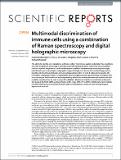Files in this item
Multimodal discrimination of immune cells using a combination of Raman spectroscopy and digital holographic microscopy
Item metadata
| dc.contributor.author | McReynolds, Naomi | |
| dc.contributor.author | Cooke, Fiona G. M. | |
| dc.contributor.author | Chen, Mingzhou | |
| dc.contributor.author | Powis, Simon J. | |
| dc.contributor.author | Dholakia, Kishan | |
| dc.date.accessioned | 2017-03-06T09:30:16Z | |
| dc.date.available | 2017-03-06T09:30:16Z | |
| dc.date.issued | 2017-03-03 | |
| dc.identifier | 249000814 | |
| dc.identifier | f8131952-68c8-434d-b1d1-61ad1bb2e3d8 | |
| dc.identifier | 85014607890 | |
| dc.identifier | 000396285800001 | |
| dc.identifier.citation | McReynolds , N , Cooke , F G M , Chen , M , Powis , S J & Dholakia , K 2017 , ' Multimodal discrimination of immune cells using a combination of Raman spectroscopy and digital holographic microscopy ' , Scientific Reports , vol. 7 , 43631 . https://doi.org/10.1038/srep43631 | en |
| dc.identifier.issn | 2045-2322 | |
| dc.identifier.other | ORCID: /0000-0002-6190-5167/work/47136406 | |
| dc.identifier.other | ORCID: /0000-0003-4218-2984/work/60195323 | |
| dc.identifier.uri | https://hdl.handle.net/10023/10402 | |
| dc.description | This work was supported by the UK Engineering and Physical Sciences Research Council under grant EP/J01771X/1, A European Union FAMOS project (FP7 ICT, 317744), and the ’BRAINS’ 600th anniversary appeal, and Dr. E. Killick. We would also like to thank The RS Macdonald Charitable Trust for funding support. KD acknowledges support of a Royal Society Leverhulme Trust Senior Fellowship. This work was also supported by the PreDiCT-TB consortium [IMI Joint undertaking grant agreement number 115337, resources of which are composed of financial contribution from the European Union’s Seventh Framework Programme (FP7/2007-2013) and EFPIA companies’ in kind contribution (www.imi.europa.eu)] | en |
| dc.description.abstract | The ability to identify and characterise individual cells of the immune system under label-free conditions would be a significant advantage in biomedical and clinical studies where untouched and unmodified cells are required. We present a multi-modal system capable of simultaneously acquiring both single point Raman spectra and digital holographic images of single cells. We use this combined approach to identify and discriminate between immune cell populations CD4+ T cells, B cells and monocytes. We investigate several approaches to interpret the phase images including signal intensity histograms and texture analysis. Both modalities are independently able to discriminate between cell subsets and dual-modality may therefore be used a means for validation. We demonstrate here sensitivities achieved in the range of 86.8% to 100%, and specificities in the range of 85.4% to 100%. Additionally each modality provides information not available from the other providing both a molecular and a morphological signature of each cell. | |
| dc.format.extent | 11 | |
| dc.format.extent | 1268346 | |
| dc.language.iso | eng | |
| dc.relation.ispartof | Scientific Reports | en |
| dc.subject | QC Physics | en |
| dc.subject | QH301 Biology | en |
| dc.subject | R Medicine | en |
| dc.subject | DAS | en |
| dc.subject.lcc | QC | en |
| dc.subject.lcc | QH301 | en |
| dc.subject.lcc | R | en |
| dc.title | Multimodal discrimination of immune cells using a combination of Raman spectroscopy and digital holographic microscopy | en |
| dc.type | Journal article | en |
| dc.contributor.sponsor | European Commission | en |
| dc.contributor.sponsor | EPSRC | en |
| dc.contributor.sponsor | The Royal Society | en |
| dc.contributor.sponsor | European Commission | en |
| dc.contributor.institution | University of St Andrews. School of Physics and Astronomy | en |
| dc.contributor.institution | University of St Andrews. School of Medicine | en |
| dc.contributor.institution | University of St Andrews. Biomedical Sciences Research Complex | en |
| dc.contributor.institution | University of St Andrews. Cellular Medicine Division | en |
| dc.identifier.doi | https://doi.org/10.1038/srep43631 | |
| dc.description.status | Peer reviewed | en |
| dc.date.embargoedUntil | 2017-03-03 | |
| dc.identifier.grantnumber | 317744 | en |
| dc.identifier.grantnumber | EP/J01771X/1 | en |
| dc.identifier.grantnumber | N/A | en |
| dc.identifier.grantnumber | 115337 | en |
This item appears in the following Collection(s)
Items in the St Andrews Research Repository are protected by copyright, with all rights reserved, unless otherwise indicated.

